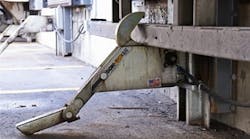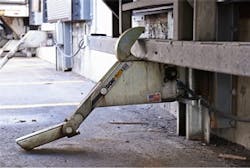Cheese manufacturer embraces FSMA
Sara Adams is more than happy to talk with you about the Food Safety Modernization Act (FSMA), which was signed into law in January 2011. In fact, she would love to.
Adams is the manager of manufacturing excellence at Sartori, a fourth generation, family-owned and -operated cheese manufacturing company located in Plymouth, Wisconsin. Being in the food business, Sartori makes it a priority to focus on food safety and quality. While most companies have yet to fully understand FSMA and its impact on the food processing industry, Adams, along with the company’s 300 employees, has been embracing the act for some time.
“I consider us to be ahead of the game when it comes to FSMA, which makes it easier for us to roll out the new standards,” says Adams.
For the past three years, Sartori’s 100,000 sq-ft converting facility — where 40-lb blocks and 20-lb wheels of Parmesan, Romano and Asiago cheese are transformed into grated, shredded and packaged products — has been operating at Level 3 certification. The certification, designated by the Safe Quality Food Institute, is the highest industry standard in food safety and quality. Further, Sartori has adopted hazard analysis and critical control point (HACCP) guidelines, which are voluntary for the dairy industry.
When Sartori built its state-of-the-art converting facility in 2008, it was designed with quality in mind. Sartori’s top management team, including the company’s senior director of quality, was directly involved in all phases of design and construction. Sartori also called in a variety of companies with a reputation for quality and expertise in food safety compliance. One of those companies was Rite-Hite, manufacturer of material handling systems.
Sartori operates six loading dock bays at its converting facility in Plymouth. The company receives hard Italian cheese from its two cheese-making facilities, along with salt and cellulose. Packaging materials like film and corrugated cardboard come in streams. So do sanitation chemicals. Finished and converted product goes out via contracted deliveries and customer pickups. Traffic from semi trailers hums in and out of the facility throughout the day.
According to FSMA, a loading dock environment can be a high-risk zone for food defense and facility security. To prevent theft, reduce contamination, and improve the safety of workers at the dock, Sartori installed Dok-Lok automatic vehicle restraints from Rite-Hite. The Dok-Lok wraps around a trailer’s rear-impact guard, securing the trailer to the loading dock. It addresses trailer separation accidents while deterring theft and can even interface with a company’s security system. Dok-Lok’s tight connection between the trailer and the loading dock also reduces holes, gaps, and other openings where dirt, debris, insects, and other environmental contaminants can enter the building.
Once a trailer is secure at Sartori’s loading dock, another Rite-Hite product, the RHV Vertical Storing Dock Leveler, helps maintain security, environmental control, and cold chain integrity. To combat security issues, the vertical leveler allows trailer doors to open inside the facility via Rite-Hite’s “drive through” application. The seal is broken inside the building, versus outside the building, which helps to ensure that product has not been tampered with, damaged, or stolen.
When it comes to environmental control, the vertical leveler allows dock doors to be closed directly on the pit floor, creating a tight seal. This tight seal minimizes points of entry at the loading dock to help maintain environmental control. And finally, the vertical design makes it easy to clean and wash down the pit floor when the leveler is stored in the upright position.
In terms of cold chain integrity, vertical levelers also help maintain Sartori’s cold dock at an ideal 34-36 °F. The close connection between trailer and dock avoids exposure to the outside atmosphere during loading and unloading of trucks. The result allows them to ensure the quality of products, from the arrival of raw materials through shipping of finished products.
“Our customers and regulatory requirements expect us to maintain the cold chain,” explains Adams. “There’s no temperature fluctuation whatsoever, whether it be very hot outside or very cold.”
Adams, who’s charged not only with implementing new regulations like FSMA, but also making sure they are living by those standards, considers the company to be miles ahead of the new food safety law. She attributes that to the visionary team at Sartori and the interest Rite-Hite has in understanding their needs and requirements.
Adams welcomes the continued rollout of FSMA and anything that may come after it. “It’s a great marketing approach to show customers that we not only meet current standards, but we’ve been meeting them for five or 10 years in some cases,” says Adams. “Going above and beyond industry standards is just a part of our quality focus at Sartori.”
Cold storage and reduced insurance costs
At Arctic Cold Storage’s 160,000 sq-ft warehouse in St. Cloud, Minnesota, loading dock employees manage between 100 and 125 truckloads of frozen foods daily for big box retailers like Wal-Mart and Target. Each week, 8-9 million pounds of product are moved in and out of the facility.
For years, tractor trailers backing into loading docks at the facility were secured manually. A yard worker would notify dock personnel via two-way radio when the trailer was secure and ready for forklifts to enter. While this system had worked for many years, an OSHA inspector pointed out some potential problems, in particular, mishaps due to human error.
“We have always viewed our employees as our most important asset,” says Jay Condon, CEO of Arctic Cold Storage. “Even though we’ve never had issues with trailer security, we felt it was time to up the safety level and put in an automatic trailer restraint and communication system.”
Condon reached out to dock design consultants from Pugleasa in Arden Hills, Minnesota. After reviewing a range of options, he decided to install Rite-Hite’s RHR-600 Dok-Lok system on 19 of the company’s 24 docks.
Designed to prevent all types of trailer/dock separation accidents, the Rite-Hite rotating hook restraint is the industry’s original and continually improving vehicle restraint. Using the energy of the backing trailer, it positions automatically. Powerful extension springs provide upward force against the rear impact guard (RIG) to keep trailers secure, including air-ride suspension trailers. The system’s universal controls feature an audible alarm with override and easy interconnecting functions. In addition, the system provides full-time communication to truck drivers outside and to dock personnel inside when entering and exiting the trailer.
Particularly important to Arctic Cold Storage was the system’s twofold approach to communication with lift truck drivers. Since products are often staged in front of the dock doors, it can be difficult for lift truck drivers or other personnel to see the restraint status on the control boxes, increasing risk and slowing productivity. Corner-Vu, part of the Rite-Vu Light Communication System, features lights on the upper corners of the interior dock doors, providing clear, concise Dok-Lok status information directly in the forklift driver’s view.
“The addition of the new restraint/communication system frees up as much as half an employee’s time per day to be used elsewhere, saving in the range of $20,000 per year,” says Condon. “We’re also expecting our insurance-related costs to go down by as much as 15%.”


